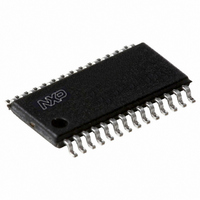P89LPC9381FDH,512 NXP Semiconductors, P89LPC9381FDH,512 Datasheet - Page 26

P89LPC9381FDH,512
Manufacturer Part Number
P89LPC9381FDH,512
Description
IC 80C51 MCU FLASH 4K 28-TSSOP
Manufacturer
NXP Semiconductors
Series
LPC900r
Datasheet
1.P89LPC9381FA112.pdf
(60 pages)
Specifications of P89LPC9381FDH,512
Core Processor
8051
Core Size
8-Bit
Speed
18MHz
Connectivity
I²C, SPI, UART/USART
Peripherals
Brown-out Detect/Reset, LED, POR, PWM, WDT
Number Of I /o
26
Program Memory Size
4KB (4K x 8)
Program Memory Type
FLASH
Ram Size
256 x 8
Voltage - Supply (vcc/vdd)
2.4 V ~ 3.6 V
Data Converters
A/D 8x10b
Oscillator Type
Internal
Operating Temperature
-40°C ~ 85°C
Package / Case
28-TSSOP
Processor Series
P89LPC9x
Core
80C51
Data Bus Width
8 bit
Data Ram Size
256 B
Interface Type
I2C, SPI, UART
Maximum Clock Frequency
18 MHz
Number Of Programmable I/os
26
Number Of Timers
2
Operating Supply Voltage
2.4 V to 3.6 V
Maximum Operating Temperature
+ 85 C
Mounting Style
SMD/SMT
3rd Party Development Tools
PK51, CA51, A51, ULINK2
Minimum Operating Temperature
- 40 C
On-chip Adc
10 bit, 8 Channel
For Use With
622-1014 - BOARD FOR LPC9XX TSSOP622-1011 - BOARD FOR LPC938 TSSOP622-1008 - BOARD FOR LPC9103 10-HVSON622-1006 - SOCKET ADAPTER BOARDMCB900K - BOARD PROTOTYPE NXP 89LPC9EPM900K - EMULATOR/PROGRAMMER NXP P89LPC9568-1759 - EMULATOR DEBUGGER/PROGRMMR LPC9X568-1758 - BOARD EVAL FOR LPC93X MCU FAMILY
Lead Free Status / RoHS Status
Lead free / RoHS Compliant
Eeprom Size
-
Lead Free Status / Rohs Status
Details
Other names
935280615512
P89LPC9381FDH
P89LPC9381FDH
P89LPC9381FDH
P89LPC9381FDH
Available stocks
Company
Part Number
Manufacturer
Quantity
Price
Company:
Part Number:
P89LPC9381FDH,512
Manufacturer:
LT
Quantity:
2 340
Philips Semiconductors
P89LPC9381_1
Product data sheet
7.17.1 Mode 0
7.17.2 Mode 1
7.17.3 Mode 2
7.17.4 Mode 3
7.17.5 Mode 6
7.17.6 Timer overflow toggle output
7.18 RTC/system timer
7.19 UART
Timer 0 and Timer 1 have five operating modes (modes 0, 1, 2, 3 and 6). Modes 0, 1, 2
and 6 are the same for both Timers/Counters. Mode 3 is different.
Putting either Timer into Mode 0 makes it look like an 8048 Timer, which is an 8-bit
Counter with a divide-by-32 prescaler. In this mode, the Timer register is configured as a
13-bit register. Mode 0 operation is the same for Timer 0 and Timer 1.
Mode 1 is the same as Mode 0, except that all 16 bits of the timer register are used.
Mode 2 configures the Timer register as an 8-bit Counter with automatic reload. Mode 2
operation is the same for Timer 0 and Timer 1.
When Timer 1 is in Mode 3 it is stopped. Timer 0 in Mode 3 forms two separate 8-bit
counters and is provided for applications that require an extra 8-bit timer. When Timer 1 is
in Mode 3 it can still be used by the serial port as a baud rate generator.
In this mode, the corresponding timer can be changed to a PWM with a full period of
256 timer clocks.
Timers 0 and 1 can be configured to automatically toggle a port output whenever a timer
overflow occurs. The same device pins that are used for the T0 and T1 count inputs are
also used for the timer toggle outputs. The port outputs will be a logic 1 prior to the first
timer overflow when this mode is turned on.
The P89LPC9381 has a simple RTC that allows a user to continue running an accurate
timer while the rest of the device is powered-down. The RTC can be a wake-up or an
interrupt source. The RTC is a 23-bit down counter comprised of a 7-bit prescaler and a
16-bit loadable down counter. When it reaches all ‘0’s, the counter will be reloaded again
and the RTCF flag will be set. The clock source for this counter can be either the CPU
clock (CCLK) or the XTAL oscillator, provided that the XTAL oscillator is not being used as
the CPU clock. If the XTAL oscillator is used as the CPU clock, then the RTC will use
CCLK as its clock source. Only power-on reset will reset the RTC and its associated SFRs
to the default state.
The P89LPC9381 has an enhanced UART that is compatible with the conventional 80C51
UART except that Timer 2 overflow cannot be used as a baud rate source. The
P89LPC9381 does include an independent Baud Rate Generator. The baud rate can be
selected from the oscillator (divided by a constant), Timer 1 overflow, or the independent
Baud Rate Generator. In addition to the baud rate generation, enhancements over the
Rev. 01 — 8 September 2006
8-bit microcontroller with 10-bit ADC
© Koninklijke Philips Electronics N.V. 2006. All rights reserved.
P89LPC9381
26 of 60















